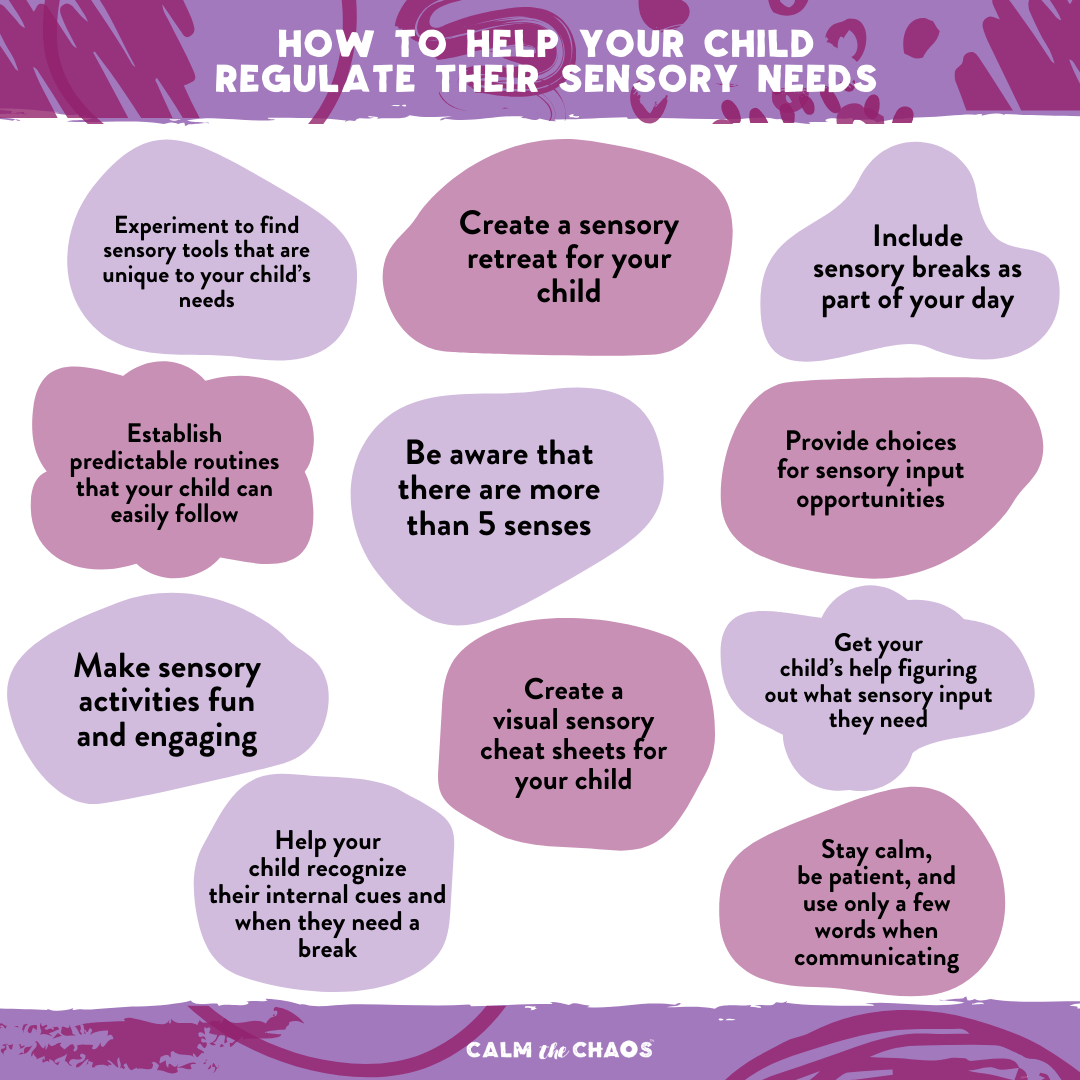Inside: Battles over socks, pajamas, or bath time wreaking havoc on your day-to-day? Try these 8 tips to handle any sensory issue that comes your way.
Does your kid get super hyper and start running around the house and jumping on everything whenever anyone comes over?
Or maybe when it’s time for bed, your child…
- Is constantly in someone else’s space
- won’t bathe or brush their teeth…
- Or refuses to wear pajamas.
Each week you wonder how on earth you’re ever going to get them to take a shower or use soap. You hope that by the time they are adults they’ll be clean!
Maybe you struggle with a picky eater...a kid who doesn’t eat vegetables because they are too “crunchy” and insists they only like foods that are white.
Mealtimes are a constant battleground.
And then there’s the endless battle over socks.
Or clothes…
They can’t be too loose.
or too tight.
or have scratchy labels.
You’re “that mom” at Target — touching the inside of every pair of pants trying to find the softest ones. Finding clothes that are ‘just right’ can be exhausting and time-consuming.
You struggle with daytime routines…
AND nighttime routines…
There seems to be no end to the list of baffling behaviors… like chewing on their t-shirt or toenails!!! (yuck!)
If this sounds familiar, and you struggle with some (or ALL) these behaviors…
I want you to know…
You are not alone.
Today I’m going to talk about how to handle these everyday sensory issues and struggles.
Not the ‘once in a blue moon’ struggles, but the daily struggles, the ones you have to deal with day in and day out. The ones that leave you baffled, confused and pulling your hair out.
The ones that you have just started to accept as part of your day-to-day.

In last week’s blog post, I talked about what sensory is. I shared some sensory behavior myths and misconceptions and why normal is overrated.
You might already know about sensory and be aware that under the surface of some of your kids’ strange behaviors are sensory needs that are not being met.
Today I’m going to share some strategies on how to deal with everyday sensory issues.
How to Deal With Everyday Sensory Issues
The truth is we ALL have unique sensory likes and dislikes.
But for some kids, their sensory needs can be overwhelming, and they melt down.
They’re screaming…
And crying…
And totally out of control.
But the good news is – They’re also trying to tell you something!
I’m going to help you figure out what that is, so you can help your child (and you) get through the day to day struggles you’re dealing with in your home.
Remember, there’s no ‘one-size-fits-all solution here.

I’m going to give you a 30,000 foot view, so you can see the strategy, understand why it works, and adapt it to the unique needs of your family.
Theresa, one of my Calm the Chaos students, noticed her kids were getting super-jiggly at bedtime. So she had them do animal walks around the house before going to bed.
They were able to get some sensory input and get rid of their jiggles, and they had the smoothest bedtime in weeks!!!
BIG WIN!!!
I want to help you find some strategies that’ll work for your family too.
But before I get into that, I want to talk about YOUR mindset.
Why Can’t Kids Just Do As They Are Told?
If you’re like me, when you were growing up, you were probably told what to do.
Put on your shoes.
Stop jumping on the furniture.
Pick up your toys.
Chances are you did as you were told.
As parents, when our children don’t comply, our instinct is to see them as defiant, disrespectful, or willfully disobedient.
But there’s really a deeper issue here.
There’s ALWAYS a reason for the behavior.
What are Sensory Issues?
To fully understand sensory issues, you need to realize there are actually 8 senses. Not just the 5 we are taught (taste, touch, sight, hearing, and smell).
There are 3 other senses that are very important:
- Your proprioceptive sense. This sense is your body awareness. It’s how you sense your body in space and determine how much pressure is too much or too little.
- The Vestibular sense is your sense of movement.
- Your interoceptive sense cues you into what’s happening internally.
What is The Interoceptive Sense?
Your interoceptive sense lets you know when…
You’re getting angry.
Excited.
When you’re hungry.
Or thirsty.
Or you need to go to the bathroom.

When this sense isn’t properly developed (as is the case with many children) those needs are not recognized. This is where a lot of those wild behaviors come from.
No one talks about this on Facebook, because they think it makes them look like bad parents.
Many people still buy into the myth that the kids are misbehaving on purpose.
But it’s not true.
You’re not a bad parent if you’re having these struggles in your family.
None of us were taught about sensory processing.
I was a teacher for 17 years, and I only started hearing about sensory processing in my last couple of years. Even then I thought sensory processing was a debilitating disorder that would ruin the quality of your life.
As I learned more about sensory, I became aware that we all have sensory preferences.
Then, after I had my own unique kids, I dove into the research, wrote a book, and began helping thousands of other parents understand what was happening with their child.
8 Ninja Tips for Dealing With Sensory Issues
So, let’s get into the eight steps you need to follow in order to help your kids deal with their sensory struggles.
Ninja Tip #1 –Put your Sensory Lenses On
When you start seeing a behavior, I want you to step back emotionally and put your sensory lenses on.
Go through the senses, one by one.
- Is their behavior related to sight or sound?
- Is it something they smell, or taste?
- Could it be that something in their body just doesn’t “feel right”?
- Maybe they need more movement, or maybe they need to be still, maybe they need to go to the bathroom?
Perhaps there’s something going on inside that they just don’t recognize or know how to deal with.
Take a good, hard look through those sensory lenses to discover what’s under the surface of the meltdown.
This approach will keep you from getting frustrated because they refused to take a shower (even though you’ve asked 50 times) or you’re going to be late for an appointment because they won’t put their socks on!
Ninja Tip #2 – Stay Calm
I know that’s easier said than done, but it’s important that you stay calm.
Do what you have to in order to take care of your own sensory needs in the moment…
Take a deep breath.
Push on your hands.
Go out and get some fresh air.
Do whatever YOU need to do to stay calm.
Then (once you’re calm), when you’re ready to interact with your child, keep your words to a minimum.
Ninja Tip #3 — Offer Choices
When your child is doing something inappropriate to satisfy their sensory needs, offer them some other options.
 If, for instance, they’re jumping on the couch, you can say:
If, for instance, they’re jumping on the couch, you can say:
“I see you need to jump.”
However, I’m worried you’re going to break the couch or hurt yourself. How about we find another place to jump?
You can jump on the trampoline, or you can jump off the wall outside.
You decide the boundaries that’ll work with your kids, and help them make those choices.
Ninja Tip #4 –Create Routines
I’m going to give you a secret Ninja tip, here.
Create routines that become an expected part of their day.
Structure and routine create normalcy for your kids. When you have routines, they know what to expect and don’t have the added stress of not knowing what’s coming next.
I know you’re probably thinking…
“My house is crazy!!! Have you met my kids?”

Related: Routine Cure
It might take a bit of planning, but adding in those routines is going to be super, super powerful.
It’s going to help you with so many of the day-to-day sensory struggles you’re having.
Ninja Tip #5 — Make it fun
People often tell me, they’ve tried sensory diets from the OT or they have done sensory activities from Pinterest.
But they didn’t involve their kids.
They just said, “Here, use this sensory thing”.
Nobody wants to have things done TO them.
So instead do something fun WITH them.
Involve them.

Like Theresa (the mom with the jiggly kids). She lives with her parents, and she had to get her kids to settle down. They had bought a trampoline to help them get the jigglies out, but the kids didn’t want to use it.
So they made up a plan that when they got jiggly, they’d do an obstacle course around the house.
And that’s exactly what they did.
They made it fun!
She involved the kids. She even made it a whispering obstacle course, so they didn’t bother grandma and grandpa with the noise!
Amazing, right?
My own kids love putting together obstacle courses. (You can see one we made here) My kids absolutely loved it!
Ninja Tip #6 — Make sensory needs part of everyday life
Now this is super important.
You want to make sure that you are including sensory throughout your entire day. It’s not just one thing. You want to include a variety of activities to support your kids’ different sensory needs.
You want to make it a lifestyle.
Look at it holistically and incorporate it into your daily activities.
One pitfall that I often see parents, teachers, and therapists fall into is giving sensory activities as a consequence. No one thinks of it as a consequence, but people will often say:
“You’re acting out, go take a sensory break.”
“You can’t sit still, so it’s time for a sensory break.”
What do you think that tells the child?
It tells the child that when I’m doing something I’m not supposed to, I have to go take a sensory break.
Then guess what they don’t want to do?
They don’t want to go take a sensory break because you’re telling them that only happens when they’re doing something wrong.
They start to internalize it as
“I am wrong.” or
“Something is wrong with me.” or
“I’m a bad kid.”

But if you make it part of your every day and mom is using it, dad’s using it, sister’s using it, everyone’s using it, it is normal and it becomes a tool for everyone.
Another comment I often hear from teachers is, “It’s not fair to give it to one kid and not another.”
I always say, make it accessible for ALL kids.
Let them try it out.
Maybe they DO need it.
Maybe it will help them become aware of their own sensory needs.
Those are my Ninja tips around making it part of their everyday life.
Make it as common as when I’m thirsty. I get water.
When I’m hungry, I eat food.
When I’m overwhelmed, I remove sensory input.
When I’m underwhelmed, I get sensory input.
It should be part of everyone’s day to day activities.
Ninja Tip #7 — Remember to Make it Visual
Draw it out or write it out.
Your kids aren’t going to not magically remember what to do in the moment, so you’ve got to make it visual.
Draw out your routines, or activities they can do, and hang it up as a simple reminder, so you don’t forget.
You don’t have to be a great artist.
Maybe your child loves to draw and you can have them help!
If you take this visual, put it on your wall and you forget about it and just expect your kids to do it…
It’s probably not going to work.
The final step to having it all come together and work is…
Ninja Tip # 8: Include your Kids in Plan
You can’t do this without your kids.
You just can’t.
A top-down approach isn’t going to work here. Instead, you have to use a family team approach where you work together to come up with a plan.
Empower them to listen to their own body and understand their own sensory preference and share their ideas and needs. You want them to learn to self-advocate.
When you work together to come up with ideas and a plan, your kids feel empowered. So instead of butting heads, they see that you are taking their needs and wants into account and will want to work with you!

So if you are battling bathtime daily, struggling with getting your kid to put clothes or pulling your hair out at mealtime just trying to get your kiddo to eat something remotely healthy…
I want you to take a deep breath and remember these things:
- Be aware of your kids’ sensory needs and change your lens.
- Stay calm. (Easier said than done, I know!)
- Offer an alternative choice for them to meet their sensory needs.
- Create a routine, so that it becomes part of your day.
- Make it FUN!
- Give them a visual reminder
- Include your kids and work together as a family team!
More Resources For Dealing with Sensory “Issues”
To help you remember some of these strategies and understand sensory behavior and what to do in the moment, I’ve put together this amazing poster set on how to understand your child’s sensory struggles and discipline sensory meltdowns.
These posters give you tips on how to help your child regulate their sensory needs, and identify what your child’s behavior is really telling you!
There’s also a list of 7 common myths about sensory behavior. I dispel these misconceptions so you can gain a deeper understanding of what sensory really is.
Ok, you might be thinking…
This all sounds great but…
- What should I do when my child is having a meltdown?
- How do I create sensory strategies that are going to help my unique child?
And, - How exactly do I get them to use those strategies in the moment?
In my next blog post, I’ll share how to create sensory tools that are going to help your specific child. I’ll also tell you what to do in the moment when your child is in sensory overload and having a meltdown!
But right now, download your FREE Handle Any Sensory Challenge posters so you can get a deeper understanding of sensory and start implementing some sensory activities and routines with your family!








Thank you for taking the time to talk about this issues and make it available. I aprésate what you do.